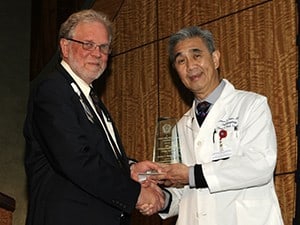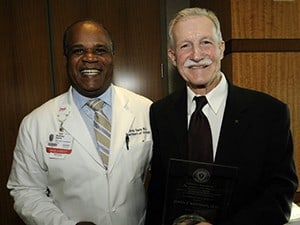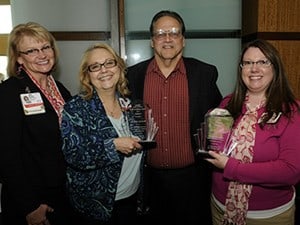College of Medicine Holds Dean’s Honor Day
April 23, 2014 | The UAMS College of Medicine paid tribute to internationally known otolaryngology leader James Y. Suen, M.D., for his 40 years of service and celebrated the accomplishments of many other faculty, staff and alumni at its fourth annual Dean’s Honor Day on April 15. Suen, chair of the UAMS Department of Otolaryngology-Head and Neck Surgery, received the Distinguished Faculty Service Award. The 1966 graduate became chief of the Division of Otolaryngology in 1974 and has served as chairman since the program became a department two years later. Suen worked with fellow faculty members, particularly Kent Westbrook, M.D., in the 1970s and 1980s to develop comprehensive cancer programs and co-found the Arkansas Cancer Research Center, now known as the Winthrop P. Rockefeller Cancer Institute. Suen was the third director, serving in 2001-2007. Suen became internationally known for his expertise in complex head and neck cancers, vascular lesions of the head and neck, and diseases of the larynx. His patients have come to UAMS from dozens of countries around the world. He has coauthored six editions of medical textbooks including “Cancer of the Head and Neck,” which is used by medical schools worldwide. “I am struck by the scope of Dr. Suen’s legacy,” said G. Richard Smith, M.D., dean of the UAMS College of Medicine. “On the one hand there is the largeness and broad significance of the Cancer Institute and Dr. Suen’s own world-renowned program. But there also are the countless individual impacts he has had on patients, students and colleagues.” The ceremony’s mix of awards for current faculty and staff and alumni brings together people who have shaped the institution over time, others who have made their mark around the world, and some who are doing exceptional work in the college now. Smith inducted former longtime Urology Department Chairman John Redman, M.D., into the college’s Hall of Fame. The 1963 graduate became a leading authority on applied anatomy of the genitourinary system, developed numerous innovations in pediatric urology, and established the state’s first pediatric urology program at Arkansas Children’s Hospital. He led urology at UAMS from 1973 to 1998 and remained on the faculty for another 11 years before retiring in late 2009. The Distinguished Alumnus Award was presented to John Byrd, M.D., a 1991 graduate who went on to become an internationally known leader in developing and testing a new class of drugs for leukemia and other lymphoid malignancies. Byrd is a physician-scientist and senior leader at The Ohio State University’s Comprehensive Cancer Center in Columbus, Ohio. Current faculty members were honored for accomplishments in education and other areas:
Three non-faculty staff members were honored for their work in the college’s major mission areas:
The college also recognized 60 faculty members who were promoted in rank, received tenure, or both, and six who were named to endowed chairs or professorships this academic year. Several faculty members were recognized for their contributions during the development and launch of a new curriculum for medical students. Smith also honored the Memphis-based Dorothy Snider Foundation, which has given the College of Medicine nearly $2 million for medical student scholarships since 1988. The foundation’s namesake, Dorothy Snider Surles, grew up in Craighead County in northeastern Arkansas during the 1920s and 1930s. |


